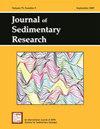伊朗盆地中部Yengejeh向斜的渐新世-中新世晚期盆地演化对阿拉伯-欧亚造山运动的响应
IF 2.1
4区 地球科学
Q1 GEOLOGY
引用次数: 1
摘要
伊朗中部盆地是在新特提斯洋俯冲后,自始新世晚期至渐新世早期以来,阿拉伯大陆和欧亚大陆之间的多幕碰撞中形成的。在此,我们提供了伊朗中部西北端Yengejeh向斜中渐新世-上中新世同生地层的详细沉积学和物源数据,包括以不整合为界的下红层、库姆层和上红层,以分析地层、沉积环境和物源。我们的研究结果表明,沉积系统在与区域变形和火山事件同时发生的五个阶段中进行了演化:a)冲积扇中的下红组沉积,其中首次出现了来自西南部近端Takab杂岩的Sanandaj–Sirjan变质碎屑,始新世晚期-渐新世早期阿拉伯-欧亚大陆软碰撞开始时发现;b) 库姆海的Burdigalian海侵和浅水碳酸盐沉积,受连续火山碎屑输入和活动火山中心熔岩流的影响;c) Burdigalian–Langhian期间干旱气候条件下,上部红组M1单元在大陆sabkha沉积,以及由于阿拉伯-欧亚硬碰撞,首次出现源自褶皱库姆组地层的内部碎屑;d) Langhian–Tortonian期间M2单元的河流沉积,沉积物来源于Qom组和Takab杂岩;和e)中新世晚期,在托托阶火山碎屑沉降一段时间后,M2单元的最上层硅化碎屑沉积在冲积扇边缘。总的来说,源-汇关系受扎格罗斯山脉结晶核心构造地形起伏的发展控制,该构造地形起伏构成了Sanandaj–Sirjan变质带的源区,通过向里海的发达排水系统向伊朗中部的西北端供应。与变形事件同时发生的岩浆相在新特提斯板块断裂之前和大陆硬碰撞之后都提供了大量的火山碎屑输入。所研究沉积记录的沉积环境和物源为世界范围内同造山带腹地盆地的发展提供了模拟,包括著名的安第斯山脉Altiplano盆地和西藏可可西里盆地。本文章由计算机程序翻译,如有差异,请以英文原文为准。
Oligocene–late Miocene basin evolution in the Yengejeh syncline in the Central Iranian Basin in response to the Arabia–Eurasia orogeny
The Central Iranian Basin has developed during a multi-episodic collision between the Arabian and Eurasian continents since the late Eocene–early Oligocene, following the subduction of the Neo-Tethys Ocean. Herein, we present detailed sedimentological and provenance data of the Oligocene–upper Miocene synorogenic strata, including the unconformity-bounded Lower Red, Qom, and Upper Red formations, in the Yengejeh syncline in the NW termination of Central Iran, to analyze stratigraphy, depositional environments, and provenance. Our results indicate that the sedimentary system has evolved in five stages coeval with regional deformational and volcanic events: a) deposition of the Lower Red Formation in an alluvial fan containing the first appearance of Sanandaj–Sirjan metamorphic clasts sourced from the proximal southwestern Takab Complex, exhumed by the onset of Arabian–Eurasian soft collision in late Eocene–early Oligocene; b) Burdigalian transgression of the Qom Sea and shallow-water carbonate sedimentation influenced by continuous pyroclastic inputs and lava flows from an active volcanic center; c) deposition of the M1 unit of the Upper Red Formation in a continental sabkha in arid climate conditions during Burdigalian–Langhian and the first appearance of internal clasts derived from the folded Qom Formation layers due to the Arabian–Eurasian hard collision; d) fluvial deposition of the M2 unit during the Langhian–Tortonian with sediments derived from the Qom Formation and Takab Complex; and e) deposition of the uppermost siliciclastics of the M2 unit at the edge of an alluvial fan during the late Miocene, after a period of pyroclastic fallout in the Tortonian. In general, the source-to-sink relationship is controlled by the development of tectono-topographic relief in the crystalline core of the Zagros Mountains that configured the source areas in the Sanandaj–Sirjan metamorphic belt supplying the NW termination of Central Iran through a well-developed drainage system towards the Caspian Sea. Coeval with the deformational events, magmatic phases supplied a large volume of volcaniclastic inputs both before the Neo-Tethys slab break-off and after the hard continental collision. The depositional environments and provenance of the studied sedimentary record provide an analog for the development of synorogenic hinterland basins worldwide along with the well-known Altiplano Basin of the Andes and Hoh Xil Basin of Tibet.
求助全文
通过发布文献求助,成功后即可免费获取论文全文。
去求助
来源期刊
CiteScore
3.80
自引率
5.00%
发文量
50
审稿时长
3 months
期刊介绍:
The journal is broad and international in scope and welcomes contributions that further the fundamental understanding of sedimentary processes, the origin of sedimentary deposits, the workings of sedimentary systems, and the records of earth history contained within sedimentary rocks.

 求助内容:
求助内容: 应助结果提醒方式:
应助结果提醒方式:


